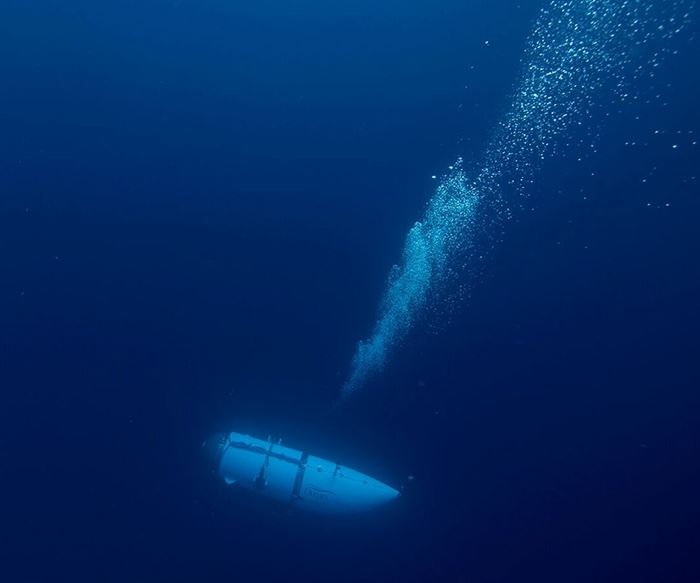OceanGate CEO pilots carbon fiber submersible in 4,000-m solo dive
4,000-m dive is the culmination of a comprehensive testing program in preparation for the vessel’s planned 2019 Titanic Survey Expedition.
OceanGate Inc. (Everett, WA, US), a provider of manned submersible services, has announced that OceanGate CEO, Stockton Rush, on Dec. 10 successfully piloted the world’s only privately-owned deep diving 5-person submersible, Titan, on a solo 4,000-m (over 2 miles) dive. Rush joins James Cameron as only the second person in history to complete a solo dive to this depth.
“This deep dive is a major milestone for OceanGate. Not only does it mean that Titan is prepared for our upcoming 2019 Titanic Survey Expedition,” says Rush, “but it also validates our innovative engineering and the repeated use of our carbon fiber and titanium hull. Titan can provide access to half of the worlds ocean depths for up to five people at a time.”
Engineered and built by OceanGate, Titan, is comprised of carbon fiber and titanium. The filament wound cylinder that forms the center section of the pressure vessel is 5" thick and made from over 800 layers of carbon fiber material. The entire pressure vessel is comprised of two titanium hemispheres, two matching titanium interface rings, and the 142 cm (56") internal diameter, 2.4-m (100") long carbon fiber wound cylinder – the largest such device ever built for use in a manned submersible. The use of carbon fiber reduces the overall weight compared to other deep-sea submersibles.
The 4,000-m dive is the culmination of a comprehensive testing program that began in 2016 with four pressure tests of a scale model, followed by construction and launch of the largest known submersible carbon fiber and titanium pressure vessel. Testing of Titan began in Puget Sound with 20 shallow manned dives, followed by a series of unmanned dives in The Bahamas to proof test the pressure hull to 4,000m in June.
Manned dive operations were conducted in The Bahamas from July to December and followed a methodical approach to validate the sub at specific depths. The 4,000-m validation dive took place on Monday, December 10, 2018 approximately 12 miles east of Little Harbour on Great Abaco Island. It took Rush seven hours to complete the dive which included multiple pauses during the descent to assess the integrity of the hull on OceanGate’s patent-pending Acoustic Real Time Monitoring system (RTM).
The RTM system is used to assess the health of the hull throughout every dive. The system uses acoustic sensors to detect sounds emitted by the carbon fiber material as it responds to the external pressure and also employs strain gauges to measure the physical deflection. The system makes it possible for Titan pilots to predict a potential failure, stop the descent and safely return to the surface.
This final step in depth validation means Titan is ready for its first major expedition – the 2019 Titanic Survey Expedition. Scheduled to begin in June 2019, it will be the first manned survey of the site since 2005. Laser scan data and images from this and future expeditions will be used to assess the Titanic’s rate of decay and produce a 3D virtual model of the wreck.
Related Content
The lessons behind OceanGate
Carbon fiber composites faced much criticism in the wake of the OceanGate submersible accident. CW’s publisher Jeff Sloan explains that it’s not that simple.
Read MoreInfinite Composites: Type V tanks for space, hydrogen, automotive and more
After a decade of proving its linerless, weight-saving composite tanks with NASA and more than 30 aerospace companies, this CryoSphere pioneer is scaling for growth in commercial space and sustainable transportation on Earth.
Read MoreMaterials & Processes: Fibers for composites
The structural properties of composite materials are derived primarily from the fiber reinforcement. Fiber types, their manufacture, their uses and the end-market applications in which they find most use are described.
Read MoreThe state of recycled carbon fiber
As the need for carbon fiber rises, can recycling fill the gap?
Read MoreRead Next
From the CW Archives: The tale of the thermoplastic cryotank
In 2006, guest columnist Bob Hartunian related the story of his efforts two decades prior, while at McDonnell Douglas, to develop a thermoplastic composite crytank for hydrogen storage. He learned a lot of lessons.
Read MoreComposites end markets: Energy (2024)
Composites are used widely in oil/gas, wind and other renewable energy applications. Despite market challenges, growth potential and innovation for composites continue.
Read MoreCW’s 2024 Top Shops survey offers new approach to benchmarking
Respondents that complete the survey by April 30, 2024, have the chance to be recognized as an honoree.
Read More
.png;width=70;height=70;mode=crop)
























